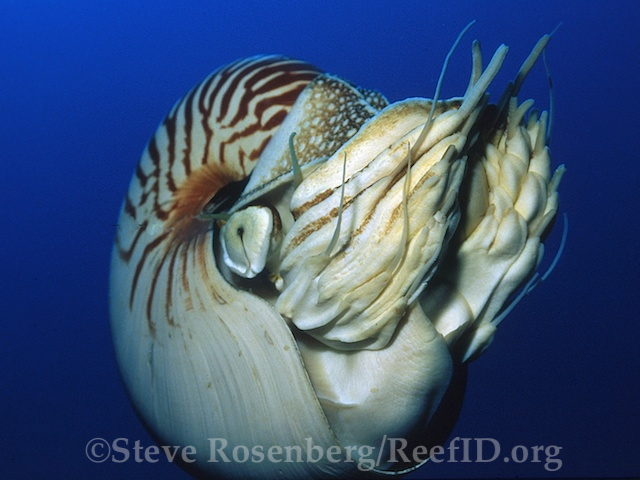By Steve Rosenberg for ReefID.org
The average life span of the nautilus is believed to be 15 to 20 years, which is unusually long for a member of the cephalopod family. Nautiluses are found throughout the Pacific and Indian oceans.  Chocolaty-brown zebra stripes adorn the nautilus’s smooth, white shell. The shell of the nautilus is comprised of many individual chambers, each sealed and filled with gas. It expands its living space as it grows, adding internal chambers in a perfect spiral coated in mother of pearl. The body is situated in the last chamber. This strong shell provides the animal with buoyancy and affords protection for the animal’s soft body. When imperiled by predators, the nautilus withdraws into its armor and seals the door with a tough, leathery hood. The nautilus has up to 90 separate tentacles, but they have no suction cups. These tentacles are used to catch shrimp, fish and small crustaceans, which the animal crushes with its powerful beak. Nautiluses are active predators, but they use very little energy while swimming, they only need to eat about once a month. Their eyesight is very poor. They rely mainly on their sense of
Chocolaty-brown zebra stripes adorn the nautilus’s smooth, white shell. The shell of the nautilus is comprised of many individual chambers, each sealed and filled with gas. It expands its living space as it grows, adding internal chambers in a perfect spiral coated in mother of pearl. The body is situated in the last chamber. This strong shell provides the animal with buoyancy and affords protection for the animal’s soft body. When imperiled by predators, the nautilus withdraws into its armor and seals the door with a tough, leathery hood. The nautilus has up to 90 separate tentacles, but they have no suction cups. These tentacles are used to catch shrimp, fish and small crustaceans, which the animal crushes with its powerful beak. Nautiluses are active predators, but they use very little energy while swimming, they only need to eat about once a month. Their eyesight is very poor. They rely mainly on their sense of smell when searching for food. An adult nautilus can grow to about eight inches (20 centimeters) in length. During the day, it resides in dark cool waters at depths from 900 to 2,000 feet and ascends to shallower waters (300 to 500 feet deep) at night to feed. At night, nautiluses ascend to shallower waters to scavenge for hermit crabs or fish.

